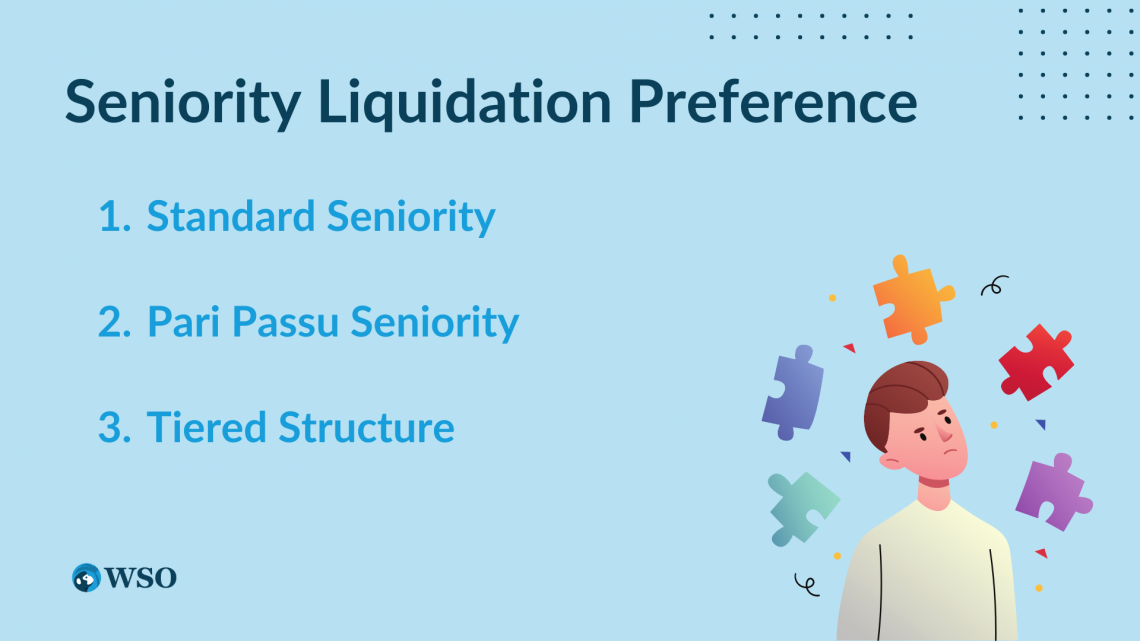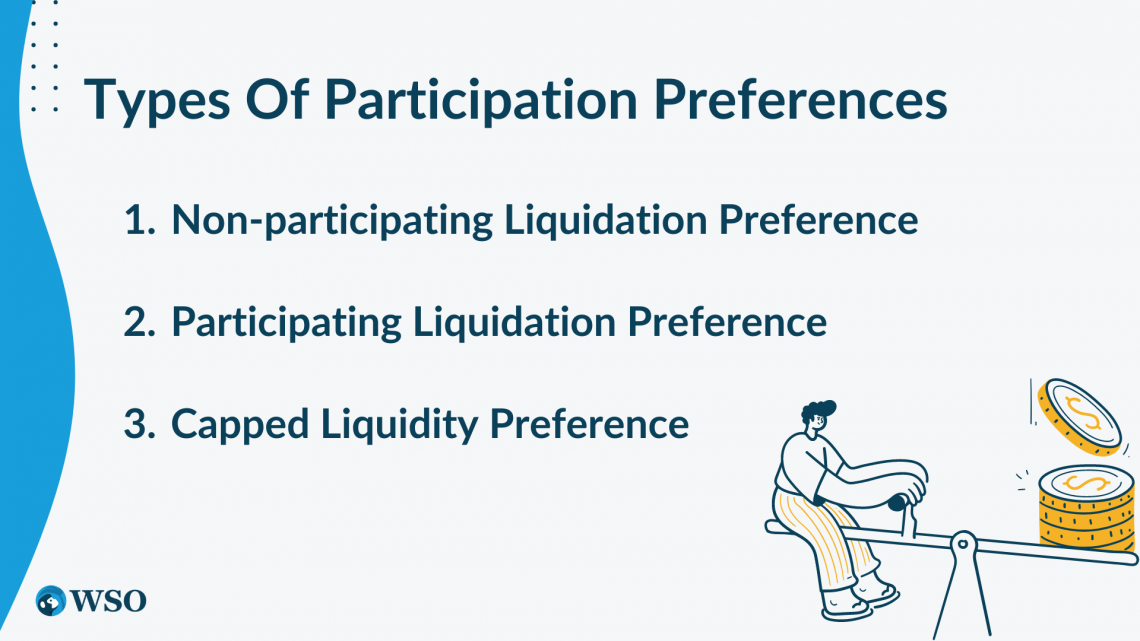Liquidation Preference
A negotiable provision made by investors and is mentioned in debt agreements and contracts.
What is Liquidation Preference?
Liquidation preference determines the hierarchy for the claims on the company's assets upon liquidation.

Venture capitalists and investors extend their funds to businesses to get a return from interest along with their initial principal. But, of course, every investment has some downside risks, and investors are always cautious.
When companies cannot repay their debts due to a long period of financial instability, the investors are negatively affected. This is because they may not receive the whole portion of their investments.
Liquidation is when the company loses its corporate status due to bankruptcy and has to distribute the claims on its assets. The company is deemed insolvent, and its assets are sold in the market.
Liquidation preference is significant to investors as it provides a safety net during a firm's liquidation. It is a negotiable provision made by investors and is mentioned in debt agreements and contracts.
It stipulates the payout order that a liquidator would distribute the company's remaining assets. A clear understanding of this structure is imperative so that investors can recoup their initial investment upon liquidation and are not uncertain whether they will receive compensation.
Key Takeaways
- Liquidation preference is the order in which the company's creditors and investors will be repaid upon liquidation.
- The priority is given to creditors first, followed by shareholders. Secured creditors have the first claim on a company's assets. Unsecured creditors, preferred and common shareholders, follow it.
- Common shareholders receive the lowest return as the assets are distributed to them after completing all other claims.
- The Court appoints a company liquidator to distribute the assets according to the hierarchy.
- Investors gain a sense of security when their investment is covered with a preference.
- Three kinds of liquidation preference exist multiple, seniority, and participation.
- Multiple liquidation preferences specify the amount, as a multiple, an investor can receive during liquidation. For example, 1x is frequently used, which represents the equivalent amount of the investment.
- Seniority liquidation preference ranks investor series based on their payment seniority. Companies have a choice between standard, pari passu, and tiered structures.
- Participation liquidation preferences provide investors with an amount based on their kind of preference shares. Investors can either own non-participating, participating, or capped preference shares.
Understanding Liquidation Preference
Liquidation preference is the order in which the company creditors and investors will be repaid upon liquidation or a wind-up. It also includes the amount each level of investor would receive.

The company's investors are queued in priority order of payments. Usually, the venture capitalists, creditors, or debtors are paid first, followed by shareholders.
The hierarchy of payments depends upon its secured or preferred status. Secured classes are the claims backed by a guarantee on the assets. Preferred status is the type of investors that receive preferential treatment during liquidation.
The order of payments is as follows:
- Secured Creditors
- Unsecured creditors
- Preferred Shareholders
- Common shareholders
It can be possible that the secured creditors, although positioned at the top-most priority, do not receive their entire portion of investments.
Common shareholders are always paid after all the claims have been reimbursed. Generally, common shareholders receive the lowest return when the company is liquidated.
The following information about the liquidity preference for common shareholders is in Apple's 2022 financial statements.
"Upon liquidation, dissolution or winding-up, the holders of shares of Common Stock are entitled to receive pro rata all assets remaining available for distribution to holders of such shares."
A liquidator is appointed by the Court to settle all the company's claims during a liquidation. They sell the assets on behalf of the company and use the receipts to pay the dues. To stipulate the order of payments, a liquidator must primarily assess the claims and shareholding.

Since secured claims are the topmost priority, they should rank first, followed by unsecured claims. The magnitude of the collateral and the debt agreement are essential characteristics to understand.
They must segregate preferred from the common shareholders and rank them according to any preferential treatment agreed on beforehand.
The most important branches of liquidity preference are multiple, seniority, and participation. These will be discussed in detail later in the article.
What Is The Purpose Of Liquidation Preference?
The provision's primary purpose is to protect investors from losing their entire or a portion of their investment when a company cannot meet any of its dues.

When a company goes bankrupt or undergoes a merger, it will pay back a minimum amount to the investor. This protects the investor's investment, reducing any downside risk.
Venture capitalists invest in start-up companies. These investments are proved to be risky, so providing a clause in the agreements creates a sense of security for the investors. In addition, they usually negotiate to be the first party to be repaid upon insolvency.
As an additional benefit to the investor, it would be possible to gain a higher return if the company and the investor were to negotiate to select the best preferential treatment. This ensures a high return on investment.
Besides investor protection, including a liquidation preference in contracts benefits the company. When more investors can get preferential treatment, they will want to invest more funds in the company. Similarly, more investors would be attracted to the company.
Liquidation Preference as Multiples
Liquidation preference can be represented as a multiple. It is the amount an investor would receive upon liquidation before the common shareholders. This multiple is an indication of their original investment.

For example, if a preferred investor receives a 1x return, they can receive their entire investment. 1x is the most common multiple offered by companies.
1x is a fair protection for investors to receive their exact investment back. The investor is guaranteed to recoup 100% capital.
Very scarcely, investments could have a multiple of 2x or more. This means that the investors would be eligible to receive double their investments during liquidation. For 3x, the amount returned is thrice the initial investment.
For example, an investor has invested $1 million in a start-up. If the investor were promised 1x liquidation preference, they would receive $1 million from the company.
If the investor were promised 2x liquidation preference, they would receive $2 million, even though they have only pledged $1 million. The amount received by an investor would be higher than the amount they have pledged if their multiple is above 1.
Suppose the company has generated sales of $2 million when the investor has a 1x preference. The investor is guaranteed to receive $1 million.
In another scenario, the company only generates $500,000. The investor will receive the whole amount because it is lower than their initial guarantee.
Seniority Liquidation Preference
This kind of liquidity preference order ranks preferred stockholders based on their payment seniority. It is widely used when there are many funding partners in the company. Every investor has their rights, and the seniority stacks the investors based on their privileges.

Standard Seniority
In this type of structure, the investors ranked last are paid first. The preferences work reversely, where the investors at the bottom are paid first.
Generally, the seed investors are the first to be paid, followed by Series A, B, C, and so on. However, with this structure, investors in Series C are paid first, followed by Series B, A, and Seed investors.
Sometimes, the latest investors are paid fully, while the early investors are paid nothing. By this, the founding investors undertake a greater risk when the proceeds from the sale are insufficient. Despite this, it is becoming popular amongst startups.
For example, the liquidation preference is 1x for the seed investors who had committed $2 million and the Series A investors who committed $1 million.
If the company's assets after a sale amount to only $1 million, the Series A investors would receive the entire amount while the seed investors are left without payment.
It follows the concept of last in, first out because the investors that fund a business during its difficult times are more helpful than the ones that had funded them during the incorporation.
Note
The seniority structure aims to stack the multiple levels of preferred shareholders.
Pari Passu Seniority
Every investor is ranked at the same seniority level in this structure. There is no preferential status for any investor; thus, all investors would share the proceeds from the sale.
If the proceeds are insufficient to reimburse every investor's whole amount, then the amount is distributed on a pro-rata basis. It means an investor would receive an amount in proportion to what they have invested.
For example, the liquidation preference is 1x for Series B and Series C investors. Suppose Series B investors have paid $2 million and Series C investors have paid $3 million. The company can pay $2.5 million back to the investors after all the asset sales.
The total capital of the investors accounts for $5 million, of which Series B has committed 25%, and Series C has committed 75%. Thus, the distribution to Series A investors is $625,000 (2,500,000 * 25%), and Series B investors are $1,875,000 (2,500,000 * 75%).
Tiered Structure
In this structure, investors from different series are grouped and paid similarly to the standard seniority. Each investor group gives the payments similarly to the pari passu seniority.
It is a combination of the characteristics of the standard and pari passu seniority. Groups or tires are formed like Series C and B or Series E to D.
Participation Liquidation Preference
There are three types of participation preferences given to preferred shareholders.

Non-participating Liquidation Preference
In this structure, non-participating shareholders can either receive the amount they have invested based on their preference multiple or convert their shares to the common one to receive a pro rata of the company's balances.
It can also be called the straight preferred stock. Intuitively an investor would want to receive the highest amount. Similarly, they would evaluate both choices and select the option that pays the most.
It is the most commonly used type of participation preference. The conversion rate to common stock is usually 1:1, which means they would receive the same amount of common shares as their preferred shareholding. However, some companies might offer a lower or higher rate.
Suppose an investor has invested $500,000 in company A for a 1x non-participating liquidation preference with 20% ownership. During liquidation, the company has collected $1 million from asset sales.
Since the investor has a non-participating liquidation preference, they can receive 1x or convert their shares to 20% common equity.
If the investor chooses the first option, they would have a guaranteed payment of $500,000. However, if the investor chooses the latter, they will receive only $200,000 (1,000,000 * 20%).
The investor would prefer to select the first option as the payout is higher ($500,000 > $200,000). However, if the sales receipt were above $2.5 million, the values from both options would be the same, and the investor would be neutral in their choice.
Participating Liquidation Preference
In this structure, the preferred shareholders rank at the senior liquidation preference, where they can receive their capital invested along with additional funds from the portion remaining to be distributed to the common shareholders.
Note
It is also called the double-dip preference shares. The term 'double-dip' is used as preference shareholders receive funds twice from the sales proceeds. The first distribution is their guaranteed liquidation preference, and the second is a participation bonus.
This structure is not commonly used because the common shareholders and the business owners are disadvantaged. The participating investors will always receive an amount higher than their guarantee, which leaves little for the non-participating investors.
Suppose an investor has a participating liquidation preference of 1x with 30% ownership. They have invested $1 million in company A. When the company liquidated, it generated $3 million from sales proceeds.
The investor would receive their guaranteed liquidation preference of $1 million along with an additional participating bonus of $600,000 ((3,000,000 - 1,000,000) * 30%)). The total exit value is thus $1.6 million.
Capped Liquidity Preference
In this structure, the preferred shareholders can only receive a preferential amount of the company's value up to a specific limit or 'cap.' If an investor chooses to receive an amount higher than their maximum limit, they must convert their shares to common equity.
It can also be called partial preference shares. This is because it combines both the features of participating and non-participating preferences. It is a popular approach to participation liquidity preference, and usually, 3x is the maximum cap.
Note
Business owners prefer this method so that the individual investors do not take advantage of the common shareholders and themselves. Introducing a limit acts like protection from all the money going to a particular investor.
Suppose an investor has a guaranteed participation liquidation preference of 2x with a 2x cap. They have invested $1 million in company A. When the company liquidated, it generated $3 million from sales proceeds.
The investor would receive their guaranteed liquidation preference of $2 million and additionally $1 million from the remaining exit value. As a result, the investor would only secure $3 million as it reaches its cap.
Suppose, in this scenario, the investor held 25% of the company through their investment. If the investor were to convert their shares to common equity, they would receive only $750,000 (3,000,000 * 25%) upon liquidation.
The investor will only choose to do so if they gain a higher amount through guaranteed payments (2,000,000 > 750,000). However, this decision would favor converting the shares if the exit value was above $8 million.




or Want to Sign up with your social account?